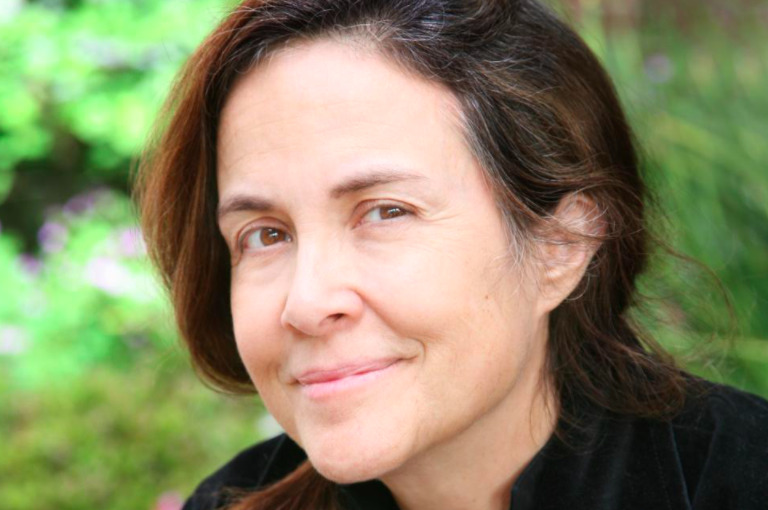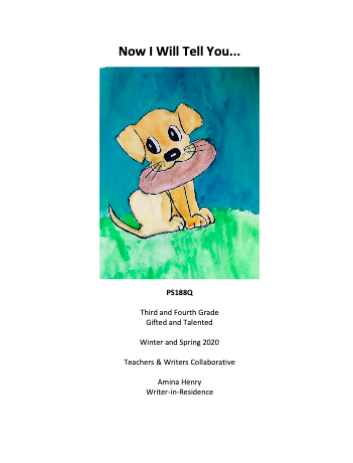This article originally appeared in Teachers & Writers Magazine, Volume 28 Issue 3, January – February 1997
I urge my students, whether elementary school age or adults, to work for “abundance” as they walk: Look hard, pick up the messages in the cracks you’ve stepped over every single morning. Later you can choose among your riches for your poem.
IN SAN ANTONIO’S INNER CITY, THE STREETS are shaded by huge aging pecan trees. It’s hard to take a walk without nuts crunching underfoot. (Students, do you notice them? Are you so used to their sounds you don’t notice anymore?) The giant Judson Candy Factory on South Flores Street has been silent for nineteen years. Too bad. The whole air used to smell like rich chocolate around here. (Does your grandma or mom remember it? What do you think they were dreaming of when they used to smell that smell?)
But the Segovia Mexican Candy factory down on Guadalupe Street has been churning out mounds of pralines since 1918 and the salsa has grown tastier in Mexican cafes since more people seem to have developed a taste for the chipotle pepper, and the Sanitary Tortilla Factory a few blocks away is bustling. Hot brown paper sacks filled with stacks of freshly pressed corn tortillas replenish the daily cupboard. And the mattress factory south of downtown still claims “Sleep is Life.” Passenger and freight trains clang through on the old tracks at two A.M. toward Del Rio, El Paso, Las Cruces-other places with lilting Spanish names.
(Do they wake you up? Are they our local lullaby?)
The warehouses by the river have been turned into the Blue Star Arts Complex-galleries, studios, and loft-style rental units. Rumor is they have a waiting list. Although it’s inspiring to see abandoned areas get lifted up like this, the heart of downtown itself shows signs of becoming a place for Temporary Visitors: knick-knack tourist stores, vendors of ugly T-shirts, pre-fab chain hotel/motels, and a Hard Rock Cafe have mushroomed as dozens of indigenous local businesses quietly disappeared. Where are all those honest, necessary places real residents used to go?
I miss the Post Office Cafe, the Stetson store, the elegant Frost Brothers department stores, the Kress dry-goods store in the spectacular art-deco building, the Alamo News Stand-I could go on and on and on. In pictures from the 1920s or 1940s of downtown San Antonio, the streets are crowded with honest daily bustle. I want to go inside these pictures and live in that other time. This city is rapidly losing what made it interesting to begin with. (Are you noticing? Are you worried about it? When we talk about using specifics in writing, can we ignore these changes that surround us?)
I wouldn’t mind new things coming in, if it weren’t at the expense of the old. If every storefront on Houston Street weren’t abandoned now that everybody’s at the sleek new downtown mall, I wouldn’t mind the mall so much.
So what about it? I tell my writing classes that if we’re noticing details, it’s our job to document local losses, to examine them closely and to think about the precious, weird little details of our own neighborhoods. “Ah, miss,” says Domingo, a student at David Crockett Elementary, “you want us to write about what changed over here, but you know it’s much more interesting to write about what didn’t change.”
“Such as?”
“My mother. She never changes.”
But Rico’s seen Domingo’s mother in a bad and good mood and he swears those moods were different. They argue awhile. Pleasantly. In the meantime I’m preparing everyone else for an “observation walk” out by Tarin’s Meat Market on Zarzamora Street and the West Side Feed Store where they used to keep an angry monkey in a cage. We’re heading out toward the gravel lots and the thirsty yards.
We will take pencils and papers. We’ll tune in with our eyes and ears. We will not speak to one another — it’s hard to observe closely if you’re jabbering. I give them questions to consider in case they go blank. They write them down for reference. “What’s right under my feet? What’s so small I would have missed it if I weren’t looking? What’s quiet? What’s pink? What’s loud? Who’s waiting for the bus? What does this smell remind me of?” We will make wild, flamboyant lists of things — the more specific, the better. We can imagine as well as record. “If you see a guy you never saw before, you can even make up a name for him. You can make up his story.”
Somebody insists, “But ma’am, there’s nothing out there! It’s dullsville, ma’am!” Everybody laughs. But they like the idea that they’re going outdoors to stretch their legs while other classes labor inside. I read poems to get the class in a receptive mood, and we talk about the poems. “It’s good to start scribbling already if a thought comes to you.” I tell them they may write in Spanish, in English, or use a mixture of both languages, as many do when they talk. (Writing teachers must always be asking themselves: how can I make this link up to their lives, and feel like home?) I write some short poems on the board to focus on. (This is crucial. They need to see poems to be able to start thinking poems.)
Aqui
Mis pasos en esta calle Resuenan
––Octavio Paz
en otra calle donde
oigo mis pasos pasar en esta calle donde
Solo es real la niebla
Here
My steps along this street resound
––Translated by Charles Tomlinson
in another street
in which
I hear my steps passing along this street in which
Only the mist is real
(“Ma’am, this guy is dreamy! I like how it’s one street mixed up with another street. Do you think it’s his memory echoing?”)
Amanecer en Buenos Aires
Rompe la luz el azul celeste
––Jose Emilio Pacheco
Amanece en la Plaza San Martin
En cada flor hay esquirlas de cielo
Dawn in Buenos Aires
Light breaks the celestial blue
––Translated by Thomas Hoeksema
It dawns in the Plaza San Martin
In every flower there are splinters of sky
Students invariably respond most warmly to connections-flower to sky, our town to Buenos Aires, or Guadalajara, or wherever. That’s just one of the reasons why it’s so important to use poems that come from other countries. I also love poems that link the little and the big.

Naranjada
Mafiana partida,
––Luis Medina Gutierrez
los gajos de nubes
dejan caer su semilla.
La naranja de sol,
muda de ropa.
Orangeade
At dawn
––Translated by Joan Darby Norris
the cloud sections drop their seeds.
The sunny orange changes clothes.
Cancion de enero
La hora es fresca y los ninos
––Alberto Blanco
en la escuela con ansiedad aguardan
el perfil de! carro de raspados:
botellas de colores que confunden con su cielo profundo la mirada.
Soles, suefios de! duke principio … el brillo de los rayos despierta
en la nieve gris de los volcanes.
January Song
The hour is cool and from the school children anxiously look for
––Translated by Julio Marzan
the profile of the snow cone cart: bottles of color that blend
long gazes with deep sky.
Suns, dreams of sweet origins … the shine of the flash is born
on the gray volcano snow.
Many times I read aloud sections of a poem too long to copy on the board and we talk about phrases and lines. I am careful to avoid the question “What does this mean?” which has been asked far too many times about poetry, as if words and images can’t mean themselves, as if they were always tricking us. I prefer, “What does this make you see or wonder? Does this remind you of anything you know? Where does it take you?”
Hopefully it will remind them of what they are going to write.
I like the long poem “La plaza” by Antonio Deltoro of Mexico, a simple but rich listing of details found in a town’s heart. The poem bounces comfortably from one line to the next, not making too much of anything, but using each item to create a sense of the whole. Here is the first third of the poem:
En la plaza
el asfalto descansa
toma vacaciones,
se vuelve pista de patinaje,
danzan las bicicletas, beben los teporochos.Hijos de papa,
con sus mamas,
salen de misa,los gorriones, gorrones
disfrutan del festin
de las palomas:
pajaros de postin,
aves de cofia blanca.El kiosko es un tiovivo
injertado en estatua,
un carrusel anquilosado
al que un dia los caballitos
abandonaron.La fuente en la plaza
es una palmera de agua,
la palmera una fuente;
la fuente y la palmera
son dos primas hermanas.Las campanas de la iglesia
llaman a misa,
las del carrito de helados
mueven a risa.
In the plaza
the pavement has a rest,
takes a vacation,
becomes a skating rink,
bicycles dance,
the winos drink.Daddy’s children,
with their mamas,
come out of Mass,the sparrows,
scroungers,
enjoy the pigeons’ banquet;
swanky show-offs,
birds with white coifs.
The bandstand is a merry-go-round
grounded as a statue,
a carousel so old-fashioned
that one day the little horses
ran away.The fountain in the plaza
––Translated by C. M. Mayo
is a palm tree of water,
the palm tree is a fountain;
the fountain and the palm tree
are two first cousins.
The church bells
call the people to Mass,
the bells on the ice cream cart
make the people laugh.
I suggest very basic techniques of listing (Nouns! Remember nouns, my friends! It’s not a “pretty” street or a “dull” street, but a street full of things! )-detailing particular attributes (“a crooked blue fence” rather than just “a fence”) and letting things bounce around inside us, creating responses. (“The trees give us shade and what do we do for them? Nothing!” writes Maria E. Gutierrez.)
I always feel I am evangelizing for the imagination in general, as all visiting writers must feel — we are meeting that wide-eyed “Aw come on!” with “Yes really! Let yourself go!” Sometimes I think the figurative, imaginative worlds have been so filtered out of young minds by now it’s best to say “Yes yes yes” to any descriptive oddity.
So, after talking and reading and discussing and note-taking, all done with supersonic swiftness in approximately fifteen minutes, off we go into the streets for the next thirty.
I urge my students, whether elementary school age or adults, to work for “abundance” as they walk: Look hard, pick up the messages in the cracks you’ve stepped over every single morning. Later you can choose among your riches for your poem. You can polish later. Tonight you may take another walk closer to your house. We’ll work on the poems during our next session, finding a few images or details we like best to center on. I tell them we’re gathering clues — just keep asking, what makes our world out here different from any other world? My biggest “victory” comes when some guy who moaned and groaned about his dull neighborhood as we were starting out says, after weeks of walking and writing, “You know, I really changed my mind about this place! I mean, those old stoves over in Ramiro’s uncle’s yard are like, they all got/aces, man! I feel like I could write ten poems about every single yard!”
In a town like San Antonio, the use of Spanish casts an even brighter light into the smiles. Even most English-speakers feel comfortable enough to pitch Spanish into our local talk, but there’s an even greater interest triggered in inner-city classrooms when bilingual students feel both their languages are being welcomed or confirmed. Even if they decide to write only in English, it changes everything, I think. It says yes to all their words.
Here are some student poems:
En la calle de la luna
As I walk I sing of darkness, I sing of clouds,
––Vangie Castillo, eighth grade
how they change like people, they meet and they flee.
I sing of people, rainbow’s light,
empty roads and wooded nights.
My voice is deep.
It sparkles to your ears
and swirls dust away.
My voice flaps and moves like a river.
It whispers to the world,
sometimes it shouts,
but always has a heart.
My voice can be a swan
and speak with its wings
but behind it is a shadow
that looks like the world.
Mi calle
bright and shiny straight and cracked y clean sidewalks y picturas de animales
––Jesus Alarcon, Jr., first grade
y people
trees beside the sidewalks
hills y mountains
and the most importante
is myself
great things around mi calle
street that leads to the city
tiendas y buildings
bonito gatitos around
mi calle
y casas y perms y barkingful wonder
buildings
and houses
roosters around mi casa su casa
who
do you think
I
am am am
?
My chicken lives in a silver ciudad.
––Ruben Hernandez, sixth grade
Mi perro lives in a dusty doghouse.
Mi gato lives in an empty trashcan
in the alley behind mi casa.
Mi hermano lives in a dream world.
En mi ciudad Martians live in mobile homes.
––Roland Morales, fourth grade
In my city it rains and shines.
En mi ciudad it rains cats and dogs from the ground up. In my city people go to restaurantes to eat.
People go to eat, and sleep in guitars.
En mi ciudad the telefono rings y people answer it.
In my city people ring and phones answer us.
After seeing a young child gripping his mother’s hand and rollerskating carefully past us, Jamshid Afshar, a fifth grader, wrote this poem:
Rollerskate!
When I rollerskate
I feel life in a way
where time is as fast as I am. When I rollerskate
I feel power, like being superior to the world.
When I turn on my rollerskates
it’s like my life changing
as I grow older. When I rollerskate
I feel that loneliness cannot catch me.
Bibliography
Blanco, Alberto. In The Tree Is Older Than You Are, edited by Naomi Shihab Nye. New York: Simon & Schuster, 1995. The translation of “Candon de enero” in that volume is by Judith Infante.
Deltoro, Antonio. In The Tree ls Older Than You Are, edited by Naomi Shihab Nye. New York: Simon & Schuster, 1995.
Gutierrez, Luis Medina. In The Tree ls Older Than You Are, edited by Naomi Shihab Nye. New York: Simon & Schuster, 1995.
Pacheco, Jose Emilio. Selected Poems, edited by George McWhirter in collaboration with the author. New York: New Directions, 1987.
Paz, Octavio. Selected Poems, edited by Eliot Weinberger. New York: New Directions, 1984.
Naomi Shihab Nye is a poet and songwriter born in 1952 to a Palestinian father and American mother. She grew up in St. Louis, Jerusalem, and San Antonio. Both roots and sense of place are major themes in her body of work.



